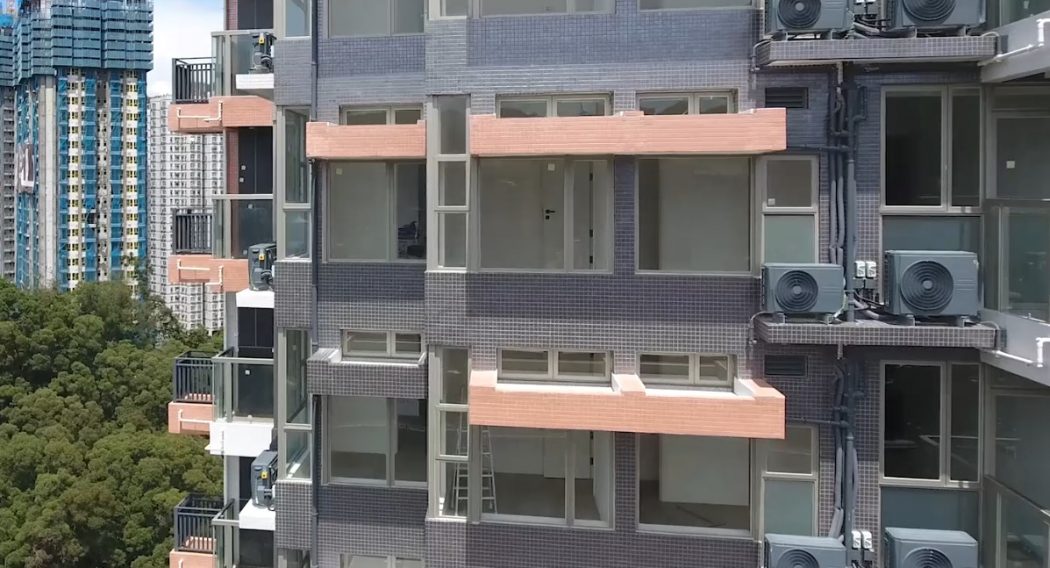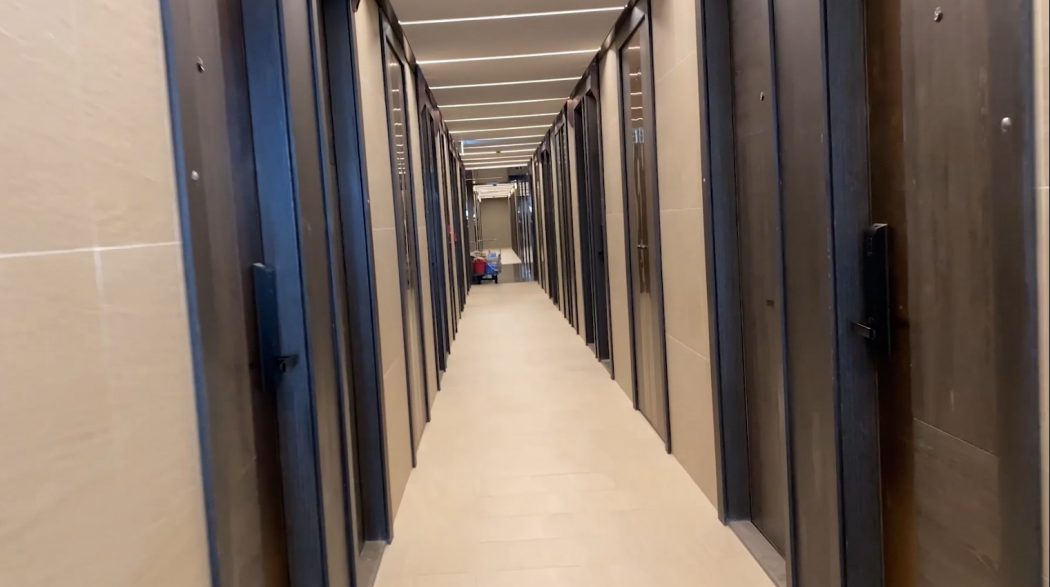The number of completed nano flats soared to nearly a thousand last year, the highest in Hong Kong’s history, as developers tried to make flats more affordable in a market of sky-high property prices. Some of the smallest flats are only 128 sq ft.
FactWire’s investigation found that the surge in nano flat construction is related to the loosening of lighting and ventilation regulations of open kitchens. Introduced by the Buildings Department in 2012, the Department changed its guidelines to allow the construction of open kitchens without their own windows. Developers have since adopted the “shoebox” design, previously applied to hotel rooms, to residential flats.

The term ‘nano flat’ has never been officially defined, but it is generally understood as flats with a saleable area smaller than 20 sq m (equivalent to 215 sq ft), or a saleable floor area smaller than 15 sq m (equivalent to 161 sq ft).
T-Plus in Tuen Mun is a well-known example of a nano flat building, with the tiniest 128 sq ft “shoebox“ built amongst 23 other nano units on every floor except the top floor. Each flat is smaller than a standard parking space for private cars.
FactWire visited T-Plus in May, when all the studio flats had already been sold or rented out. An owner invited us to her 168 sq ft flat in its final stage of renovation. As our reporter stepped into the flat, to their left was a windowless toilet and directly in front of them was a rectangular-shaped living–cum–dining room. About one-third of the room was occupied by a three-foot-wide bed.
Adjacent to the bed was an open kitchen. Its working table was barely able to contain a sink and an induction cooker. In order for the washing machine to fit into this limited space, the sink was not even three inches deep.

A balcony at the end of the room was the only source of natural light as there was no other window in this entire flat. “The flat is too small for couples,” said the owner who spent about HK$ 2.7 million purchasing this off-plan property for her own use. “It is hard for even a slightly fatter person to enter. The toilet bowl is too close to the sink and I must be careful to avoid bumping my head against it,“ she said.
In order to make nano flats look more spacious, water heaters and aircon pipes are often installed inside the walls, rendering them more difficult to repair. Some electronics, like the kitchen hood and induction cooker, are also pre-fixed into certain positions.
The surge in nano flat construction first appeared in 2014. According to the Buildings Department, only 222 nano flats were issued a “Consent to Commence Works” in 2013. The number quickly increased sixfold to 1,385 flats in 2014, reaching a peak of 3,016 flats in 2017. It levelled off in recent years, although the number of such flats remain at over a thousand.

The latest data from the Transport and Housing Bureau show that a record high of 982 nano flats were completed last year, accounting for 7.2 per cent of total completed constructions that year.
A lot of newly–built nano flats, including Hung Hom’s Upper East and North Point’s “One Prestige” complex, have similar interiors. Open kitchens and toilets without any windows are some common features.
FactWire’s investigation found that the construction of nano flats rocketed at the same time the government introduced policies to restrict flat size and numbers in land sales, while loosening the requirements for residential open kitchens.

In the 2010/11 budget, the Financial Secretary at that time, John Tsang, announced that the government was preparing to increase the supply of small and medium-sized flats by specifying the minimum number of flats and the range of size of such units in the land sale conditions.
Following that, the Secretary for Development at the time, Carrie Lam, introduced in June 2011 another policy that stipulates the minimum flat number of certain sites.
Subsequently, the requirements for open kitchens were also loosened. In 2011, the Buildings Department issued the “Code of Practice for Fire Safety in Buildings 2011”, specifying that units with open kitchens should be installed with a smoke detector, a sprinkler head, and a full-height wall that would be able to resist fire for half an hour. This replaced earlier requirements for a traditional kitchen. Previously, kitchens were to be separated from the rest of the premises by walls and a door that would be able to all resist fire for an hour and half an hour.

According to the Fire Services Department, there were only 120 approved and completed residential units with open kitchens back in 2011. Immediately after the issue of the “Code of Practice for Fire Safety in Buildings 2011”, the number of open kitchen units rocketed eightfold to 1,020 in 2012. By March of this year, the total number of units with an open kitchen had reached about 38,070.
Although fire safety requirements for open kitchens have been loosened, the “Building (Planning) Regulations” still requires residential kitchens to be constructed with windows. However, that is not the case in most of the nano flats we see today.
FactWire found that the Buildings Department, on the industry’s discussion forum in 2012, confirmed that an open kitchen and its connected living-cum-dining room would be considered as a whole when dealing with lighting and ventilation requirements. This meant that an open kitchen would no longer require its own window.

The APSEC Discussion Forum is held every two to four months for the Buildings Department to respond to the industry’s questions about buildings regulations. In the documents of a session on May 18, 2012, the Hong Kong Institute of Architects suggested that an open kitchen and a living-cum-dining room could be considered as a whole in terms of lighting and ventilation.
The Institute proposed that the room’s window should follow the requirements under sections 30 and 32 of the “Building (Planning) Regulations”, except that the ventilation area should be “slightly increased” to what is required under section 36 for rooms containing soil fitments, this being that the openable area of the window(s) must be at least one-tenth of the room’s floor area.
According to the proposal, except for the “slight increase” in the ventilation area, the rest of the requirements should be the same as a living–cum–dining room without an open kitchen. It then requested the Buildings Department to confirm its suggestion.

The Buildings Department, in its response, acknowledged the Institute’s suggestion of considering an open kitchen and the room as a single unit, adding that the “open kitchen should be located in a position where most of the open kitchen area could face the concerned prescribed window(s) of the room for the required natural lighting and ventilation.“
However, the Department rejected the proposed “slight increase“ in ventilation area, by stating that “the calculations of the openable window area provision for a living room with an open kitchen can be based on the requirements stipulated in section 30(2)(a)(ii) instead of that in section 36(2)(b).“
The required openable window area under section 30(2)(a)(ii) is one-sixteenth of the room’s floor area, smaller than what is under section 36(2)(b).

“The loosened restrictions for both open kitchens and toilets to not require windows have made it possible for residential units to be rectangular in shape, like shoeboxes,“ said Vincent Ho, former president of the Hong Kong Institute of Surveyors.
“When we look at the earlier designs, there is usually a lightwell acting as the source of natural light for kitchens, through their own windows,” he said, “now it is no longer necessary.“
Ho described to FactWire that by excluding the space for lightwells, units could now be arranged very closely to one another in an array.
‘For example, if the building was 50 metres in width, a unit would simply be divided into rooms within those 50 metres. The same would apply to the unit next to it. This way, a lot of units would be able to fit into the building. The number of units would definitely be more than if a separate space had to be arranged for kitchens,’ he explained.
He added that this kind of design would reduce the external wall area, minimising the overall cost. Public space such as the corridor would also be shortened. This would be more suitable to the relatively narrower sites in urban spaces, allowing more units to face the street.

Apart from open kitchens, windowless toilets also became allowed in Hong Kong’s regulations. In December 1997, the Buildings Department officially accepted the use of artificial lighting and mechanical ventilation as written in the “Practice Note for Authorized Persons and Registered Structural Engineers 219”. The Practice Note, which was issued by the Building Authority (who is also the Director of Buildings) without having undergone any public consultation, overrode the requirement of a toilet window written in section 36 of the “Building (Planning) Regulations”.
Stewart Leung, Chairman of The Real Estate Developers Association of Hong Kong, disagreed with the claim that the modification in regulations was to make it easier for developers to build nano flats. He stressed that the emergence of nano flats was only to meet market demands.
“Developers know the property market well. They look at the districts and the buildings in those districts to identify potential targets and to determine the suitable flat size and price before asking architects to work on a corresponding plan,“ he said, “Every major developer has its own team of architects to cater to their needs.“
Embed from Getty ImagesWhen asked whether the industry had spoken with the government before the modification in regulations were imposed, Leung firmly said “no“. “The government would never respond,“ he noted, “It only restricts the number of flats in its land sale conditions as well as the minimum flat size for developers to follow. Other than that, the government is not teaching you to do business. Developers have to find their own markets.“
Franklin Yu, Vice President of the Hong Kong Institute of Architects, was a member of APSEC in 2012. He admitted that the Buildings Department’s interpretation of the lighting and ventilation requirements for open kitchens has had a “significant impact“ on current building designs.
Yu told FactWire that the modifications to the toilet and kitchen requirements were originally intended for offices and hotel rooms. It was only later that the industry realised how spaces in residential flats were similarly not utilised as “efficiently“. Since flats were dwindling in size, compounded with the limited external wall area, it became challenging to design flats with windows in each toilet and kitchen.
As an alternative, Yu said that the open kitchen design “kills two birds with one stone“. “People like open kitchens too, as long as fire safety, lighting and ventilation issues can be solved,“ he said.

When asked about the APSEC Discussion Forum in 2012, he responded, “that was indeed just a discussion, not really a suggestion (by the Hong Kong Institute of Architects).“
In his opinion, the current lighting and ventilation requirements for open kitchen units are in fact stricter than those for a traditional kitchen, because the required amount of external air that a window in a habitable room (for example, the living and dining room) must face is more than what is required of a kitchen.
According to the “Buildings Department’s Practice Note“ on lighting and ventilation requirements (APP-130), the Vertical Daylight Factor required in a habitable room is eight per cent. In comparison, only four per cent is required in a kitchen.
Yu admitted that this kind of design has made it easier for developers to build smaller flats. At the same time, he acknowledged that “a flat that is too small might not be suitable for living… it might be okay for one person, but not two.“
Johnny Au was the Director of Buildings at the time the Buildings Department issued the new fire safety code in 2011 and confirmed the lighting and ventilation requirements for open kitchens in 2012. He was once suspected of possessing illegal structures in his home during his term of office. The Buildings Department at the time issued a statement claiming that the concerned structures were “exempted building works“.

Au was also accused of charging Henry Tang for the illegal structures at his house but not those of Leung Chun-ying, the Chief Executive-elect at the time, whose house also contained suspected illegal structures. Au denied the accusation of bias, claiming that the two cases were incomparable to each other.
Following his retirement in 2014, Au is currently one of the Vice Presidents of the Hong Kong Institute of Real Estate Administrators. He is also a member of the Hong Kong Housing Society’s Supervisory Board and the Land and Development Advisory Committee.
Another official involved, Leung Chin-man, was the Director of Buildings in 1997. This was the same year the Buildings Department issued the Practice Note modifying the lighting and ventilation requirements for toilets. Leung later took up the posts of the Director of Housing and the Permanent Secretary for Housing, Planning and Lands.
Embed from Getty ImagesAfter retirement, Leung became the Executive Director and the Deputy Managing Director of New World China Land Limited (NWCL) with an annual income of over HK$ 3 million. Consequently, a Select Committee of the Legislative Council was set up to inquire into matters relating to Leung’s post-service work, concluding that there was a conflict of interest for Leung to join NWCL.
FactWire sent an enquiry to the Buildings Department to clarify the lighting and ventilation requirements for open kitchens before they were specified in the “Code of Practice for Fire Safety in Buildings 2011”. FactWire also asked it to confirm whether the absence of a window in an open kitchen is a violation of the “Building (Planning) Regulations”, and inquired why the requirements for an open kitchen were stated on the APSEC Discussion Forum instead of on an official legislation amendment. No response has been received thus far.
According to statistics of the Rating and Valuation Department, the saleable floor area of private residential properties has been declining over the past decade. The average saleable floor area of properties that commenced work from 2010 to 2015 ranged from 400 to 600 sq ft. In 2016 it dropped to only 326 sq ft, and has remained at a level lower than 350 sq ft until today.

A lot of nano flats are even smaller than public rental housing units. Taking reference from a document of the Housing Authority, the saleable floor area of public rental housing units for one person is 160 sq ft. The saleable floor area of nano flats is, however, generally even lower than 161 sq ft.
Renting a nano flat is not as cheap as one might expect. The monthly rent of a unit with a saleable area of 173 sq ft in Jordan’s “AVA 62” is HK$ 12,000. That is about HK$ 69 per sq ft. As for a unit of 170 sq ft in Tuen Mun’s “T-Plus”, the monthly rent is HK$ 7,800, which is about HK$ 46 per sq ft.
